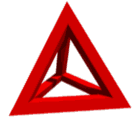Tetrahedral Trouble

Suraj is holding a tetrahedron net that has all integer side lengths (although the faces don't need to meet up to form an actual tetrahedron, just that the sides can create faces).
He says to his friend Binay, "The lengths of 5 of the 6 edges are as follows: 17, 23, 40, 58, 65. You have 3 chances to guess the sixth length."
Binay guesses intelligently 3 times.
What is the probability that Binay gets it correct within the 3 guesses (to 3 decimal places)?
The answer is 0.107.
This section requires Javascript.
You are seeing this because something didn't load right. We suggest you, (a) try
refreshing the page, (b) enabling javascript if it is disabled on your browser and,
finally, (c)
loading the
non-javascript version of this page
. We're sorry about the hassle.
All of the faces must satisfy the triangle inequality: a + b > c (it can't be equal).
Consider an edge A . Without loss of generality, A will create two faces: A , B , C and A , D , E . This means that there is exactly one edge F that doesn't create a face with A (and similarly for each edge that is considered).
Also note that if we swap B and C around, and also swap D and E around, the collection of faces on the right of the diagram don't change (meaning that we can fill in edges that we know later on without the loss of generality).
Assuming that A = 1 7 , consider the edge with length 2 3 . If 1 7 was to create a face with 2 3 , the third edge of the triangular face cannot be 4 0 , 5 8 or 6 5 as these don't satisfy the triangle inequality so the face would have to be { 1 7 , 2 3 , ? } . Alternatively, 1 7 and 2 3 could be edges that are opposite and don't create a face.
Assuming that A = 1 7 , consider the edge with length 4 0 . If 1 7 was to create a face with 4 0 , the third edge of the triangular face cannot be 2 3 , 5 8 or 6 5 as these don't satisfy the triangle inequality so the face would have to be { 1 7 , 4 0 , ? } . Alternatively, 1 7 and 4 0 could be edges that are opposite and don't create a face.
Now we have 2 different pairs of options:
Now we must select one option from each row. However, since only one edge can be opposite 1 7 we cannot have the purple and orange together (also the 1 7 and ? can't be on two faces together if blue and red are together). Therefore either the blue and orange statements are true or the purple and red statements are true.
Case 1: { 1 7 , 2 3 , ? } forms a face, and 1 7 is opposite 4 0
We can fill in 2 3 and ? as B and C (proven above that this is without loss of generality) meaning that we get: A = 1 7 , B = 2 3 , C = ? , D = , E = , F = 4 0 . Now since we know that { B , D , F } forms a face, due to the triangle inequality, D < 2 3 + 4 0 meaning that D must equal 5 8 .
This means that: A = 1 7 , B = 2 3 , C = ? , D = 5 8 , E = 6 5 , F = 4 0 . We can now compare all these numbers with the triangle inequality for all 4 of the faces that are shown on the diagram. Checking, we see that the ones with known numbers satisfy, and we also get that 2 5 < ? < 4 0 giving us 1 4 possible integer values for ? .
Case 2: { 1 7 , 4 0 , ? } forms a face, and 1 7 is opposite 2 3
We can fill in 4 0 and ? as B and C (proven above that this is without loss of generality) meaning that we get: A = 1 7 , B = 4 0 , C = ? , D = , E = , F = 2 3 . Now since we know that { B , D , F } forms a face, due to the triangle inequality, D < 4 0 + 2 3 meaning that D must equal 5 8 .
This means that: A = 1 7 , B = 4 0 , C = ? , D = 5 8 , E = 6 5 , F = 2 3 . We can now compare all these numbers with the triangle inequality for all 4 of the faces that are shown on the diagram. Checking, we see that the ones with known numbers satisfy, and we also get that 4 2 < ? < 5 7 giving us another (distinct) 1 4 possible integer values for ? .
Binay now knows that there are 1 4 + 1 4 = 2 8 possibilities for the sixth edge length.
Since Binay won't guess the same thing twice, P ( Not guessing correctly ) = 2 8 2 7 × 2 7 2 6 × 2 6 2 5 = 2 8 2 5 Therefore, P ( Guessing correctly ) = 1 − 2 8 2 5 = 2 8 3 ≈ 0 . 1 0 7